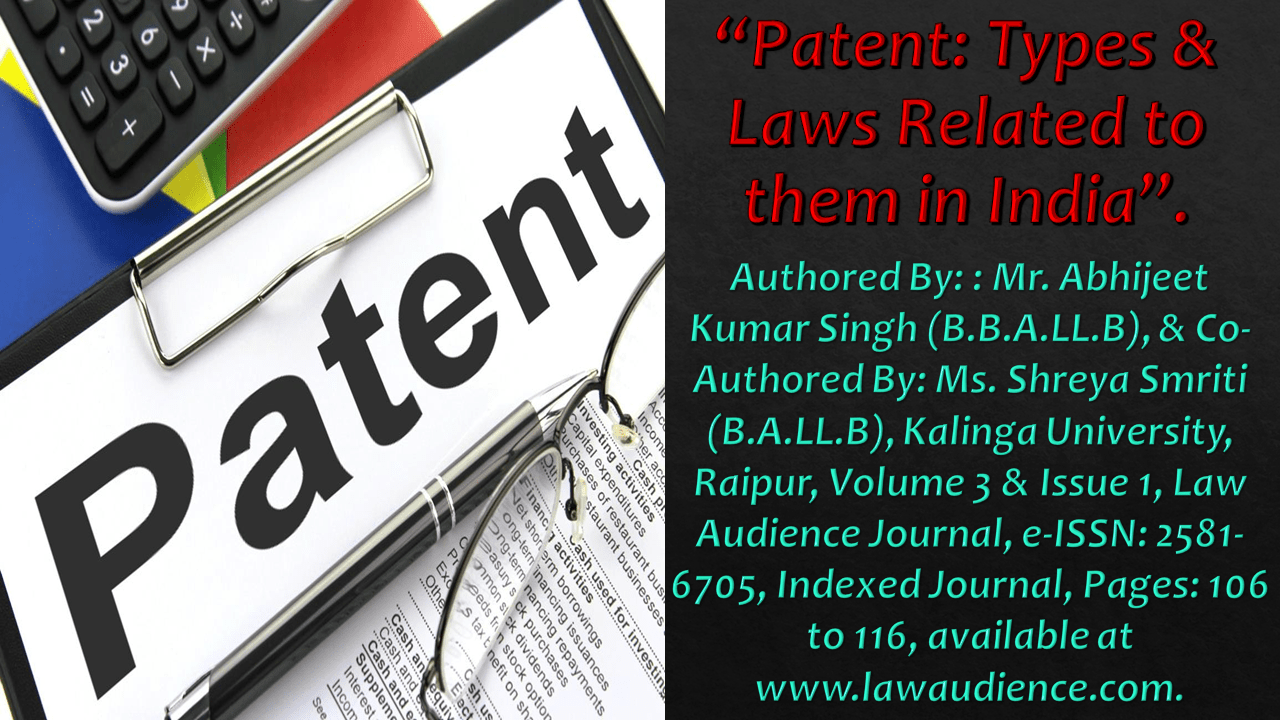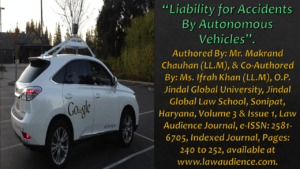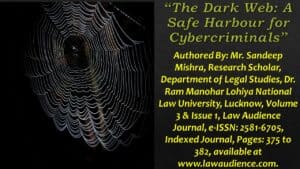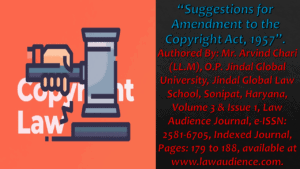Click here to download the full paper (PDF)
Authored By: Mr. Abhijeet Kumar Singh (B.B.A.LL.B), & Co-Authored By: Ms. Shreya Smriti (B.A.LL.B), Kalinga University, Raipur,
Click here for Copyright Policy.
ABSTRACT:
“Intellectual property is a legal term that refers to the legal right provided to an inventor to safeguard his or her innovation. It is a legal right that protects the owner’s creativity, innovation, symbol, design, etc., allowing them to enjoy their property without interference from others by prohibiting others from using or duplicating them for a certain period. Intellectual Property (IP) is an intangible asset created by human inventiveness. Intellectual property comes in various forms, including patents, trademarks, copyright, and geographical indications. A person’s intellectual property rights provide him or her the exclusive right to utilize his or her invention, which implies that no one may duplicate or use the design without the creator’s or inventor’s prior consent. This article will address just the many kinds of patents and the rules that govern them in India”.
I. BACKGROUND INFORMATION:
A patent is a kind of intellectual property right, similar to a trademark or copyright. The name “patent” comes from the Latin word “pater,” which means “to lay open,” i.e., to make accessible for public examination. A patent is a license that confers on the owner an exclusive right or title to prohibit others from creating, using, or selling an invention for a limited or defined length of time, and the violation of the patent holder’s exclusive rights or title is referred to as patent infringement. Patents Act, 1970, governs patents in India. The primary goal of the Patent Act is to incentivize individuals to develop innovative ideas in their fields by providing them with exclusive rights to their creations.
I.I PATENT HISTORY[1]:
Act VI of 1856 established the first patent laws in India, which was later abolished by Act IX of 1857 due to its enactment without the assent of the British Crown. Another piece of law was introduced in 1859 with the purpose of giving ‘special privileges.’ This Act is referred to as Act XV of 1859. This law modifies earlier laws in many ways, including limiting exclusive rights to valuable innovations, extending the priority period from six to twelve months, and eliminating importers from the category of investors. The Act of 1859 was combined in 1872 to offer protection for designs. Statute XIII of 1872 revised the Act, renaming it “The Patterns and Designs Protection Act.” This statute stayed in effect for 30 years until being altered again in 1888.
The Indian Patent and Design Act, 1911 abolished all prior legislation. The current Patent Act, 1970, was enacted in 1972, revising and consolidating the pre-existing legislation on Patents in India.
This statute was changed again in 2005 by the Patents (Amendment) Act, which broadened the scope of product patents to all or any disciplines of technology, including food, pharmaceuticals, chemicals, and microorganisms. This amendment abolished provisions pertaining to Exclusive Marketing Rights (EMRs) and replaced them with a clause authorizing the issue of compulsory licenses and allowing for pre-and post-grant opposition.
II. INDIA’S PATENTABILITY CONDITIONS[2]:
Not every innovation is patentable. A patent is issued to the inventors after their innovation fulfills the patentability requirements. Sections 3 and 4 of the Patent Act, 1970 include a list of exceptions to the rule that are not deemed innovations and hence not patentable.
Three requirements must be met by the inventor in order to get a patent for his idea. These include the following:
- The innovation must be new, which means it must not already exist.
- The innovation should be commercially viable.
- The invention must be novel, which implies that it must be a substantial advance over the prior art.
III. PERSONS ELIGIBLE TO SUBMIT A PATENT APPLICATION[3]:
Section 6 of the Act states who is eligible to file a patent application for an invention. Subject to the requirements of section 134, the following individuals are eligible to file a patent application:
- The application may be made by anyone claiming to be the true and first inventor of the invention;
- It may also be made by anyone claiming to be the actual and first creator in respect of the right to make such an application; and
- It may also be made by the legal representative of any deceased person who was entitled to make such an application immediately before his death.
IV. PATENT TYPES[4]:
A patent protects the inventor’s innovation and novel and non-obvious findings. There are three distinct sorts of patents, each of which covers a particular creation. However, an invention may be eligible for more than one form of patent.
The three separate categories of patents are described below;
IV.I Patents d’utilité:
This sort of patent protects novel and beneficial techniques, materials compositions, machines, and manufacturers. This is the most often sought kind of patent. Additionally, it may be gained for new enhancements to current processes, matter compositions, equipment, and manufacturers.
As an Indian inventor seeking to register a utility patent, one may do so in Nations such as Australia, the United Arab Emirates, China, Germany, France, and a number of other European Union member states.
IV.II Patents on Designs:
A design patent is defined as an object’s “surface decoration,” which may also cover the object’s form or structure. This form of the patent is only available when the design is inextricably linked to the item. This form of patent covers the look of the thing solely. If a person wishes to protect an object’s functional or structural characteristics, he or she must also submit a utility patent application.
IV.III Patents on Plants:
Patents on plants are often sought to protect novel and unusual plants. To qualify for this sort of patent, the plant must not be tuber propagated (i.e., an Irish potato), it must not be found in an uncultivated condition, and it must be capable of asexual reproduction. Asexual reproduction refers to the process of reproducing a plant by grafting or cuttings rather than seed. As with utility patents, plant patents are now unavailable in India; however, they are available in Australia, the United States of America, and numerous European nations.
V. APPLICATIONS FOR PATENTS UNDER THE PATENT ACT, 1970:
V.I Proviso[5]:
It is a provisional application filed with the patent office in order to assert priority. Essentially, this form of application is submitted when an inventor needs additional time to perfect an idea.
This application is advantageous since the Indian Patent Office operates on the basis of the “First to File” principle. By submitting early, the inventor avoids any subsequent innovations becoming prior art to the inventor’s application. A full specification must be completed within 12 months of the date of submitting the provisional application; failing to do so will result in the application being canceled.
V.II Non-Provisional Or Ordinary Application[6]:
The applicant files a Non-Provisional Application with the patent office if he or she does not have any claim to priority. This application must be supported by a comprehensive specification that fully describes the invention.
V.III Typical Application[7]:
A convention application is a patent application filed with the Patent Office that claims priority over an identical or substantially similar application submitted in one or more of the convention nations.
To get convention status, an applicant must submit the application with the Indian Patent Office within 12 months of the date on which an identical application was first filed in the convention nation.
V.IV International Patent Application PCT[8]:
It is a simplified patent application procedure that allows for simultaneous filing in several countries. The Patent Corporation Treaty governs it, and it is valid in up to 153 Nations. The benefit of submitting this sort of application is that just one international patent application is necessary to seek protection for innovation in up to 153 Countries worldwide[9].
V.V Application for the National Phase of the PCT[10]:
The inventor files this form of application in each nation where he or she wishes to seek protection. This application must be submitted within thirty or thirty-one months of the priority date or the date of international filing, whichever is sooner.
V.VI Patent Application for Addition[11]:
This kind of application is filed when an applicant makes an improvement or change to the invention specified or disclosed in the main application for which he or she has previously applied for or secured a patent. Because a patent of addition may be awarded only after the parent patent has been granted, it is not required to pay a fee again for the renewal of the same patent again. The patent, once done, will last for a lifetime with no extra cost.
V.VII Application by Division[12]:
When an applicant’s application claims more than one invention, the applicant may split the application and submit two or more applications, one for each of the claimed inventions, on his or her own or in response to an official objection. This form of application, which is distinct from the parent, is referred to as a Divisional Application. Each and every divisional application will have the same priority date as the Parent Application (Ante-dating). A divisional application shall be granted a patent for a period of twenty years from the date of filing of the main application.
VI. PROCEDURES FOR PATENT GRANT[13]:
Once a patent application is filed, a request for examination of the application must be filed with the Indian patent office within 48 months after the application’s priority date or first date of filing. After the application is examined, the first examination report is provided, and the applicant is given a chance to respond to the report’s concerns. The applicant must comply with all requirements within six months of the issuance of the first examination report, which may be extended for an additional three months at the applicant’s request, and if the applicant does not comply with all requirements in the first examination report within the prescribed period of nine months, the application is treated as abandoned by the applicant. After all, objections have been addressed, and all conditions have been met, the patent is awarded and published in the Patent Office Journal.
VII. OPPOSITION TO PATENT GRANT[14]:
Section 25 of the legislation deals with patent opposition. Oppositions are classified into two types;
VII.I Prior to Grant Opposition:
Pre-grant opposition is addressed under Section 25(1) of the legislation. It specifies that any individual may make an objection to the issuance of a patent in writing after the publication of the application and prior to the distribution of the patent.
VII.II Opposition to Grants:
Post-grant opposition is addressed under Section 25(2). These are the complaints submitted by the applicant after the issuance of the patent. These objections must be made to the controller within one year after the publication of the notice of grant of a patent.
The opposition notification must include the following information:
The nature of the opponent’s interest; the circumstances surrounding the opponent’s objections; and the relief sought by the opponent.
VIII. OBJECTIVE GROUNDS[15]:
The pre-grant objection may be brought on any of the grounds set forth in section 25(1)(a) to (k) of the Patent Amendment Act, 2005:
Wrongfully obtaining the invention; anticipation by prior publication; prior claiming in India; prior public knowledge or use in India; obviousness and lack of inventive step; non-patentable subject matter; insufficiency of a description of the invention; failure to disclose required information; or providing a materially false statement. As with the pre-grant objection, a post-grant complaint may be submitted for any of the reasons outlined in section 25(2) of the Act. It is worth noting that some of the reasons are identical to those necessary for pre-grant opposition filing.
IX. INFRINGEMENT OF PATENT[16]:
Patent infringement is the breach of the patent holder’s exclusive rights. As previously stated, a patent is a license that grants the inventor an exclusive right or title to an invention for a specified period of time in order to prevent others from making, using, or selling the design, and the violation of the patent holder’s exclusive rights or title is referred to as patent infringement. It encompasses acts such as the unlawful use, manufacturing, sale, or offer for sale of the subject matter or the illegal invention in another person’s patent.
There are two distinct types of patent infringement, which are discussed here:
IX.I Violations Committed Directly:
Direct infringement takes place when a product that is significantly similar to a patented product or innovation is promoted, sold, or utilized commercially without the owner of the protected product or invention’s authorization which shows that a person did it intensionally or willingly with the motive of making profit out the other person’s work/product.
IX.II Unintentional Infringement:
Indirect infringement occurs when a degree of deception or inadvertent breach occurs without the infringement being intended and that unintended infringement shows the absence of mens rea where the person/entity does not seek to trouble a another person with the patent of that work.
X. REMEDIES FOR BREACH OF A PATENT[17]:
Section 108 of the Act provides for the reliefs that a court may issue an infringement litigation, which may include an injunction subject to such restrictions, if any, as the court deems appropriate and, at the plaintiff’s choice or option, either damages or an account of profits. Additionally, the court may order those infringing items, as well as materials and implements whose primary purpose is in the manufacture of infringing articles, to be confiscated, forfeited, or destroyed, as the court considers appropriate in the circumstances of the case.
XI. INDIA’S EXCEPTIONS OR LIMITATIONS ON PATENT RIGHTS:
XI.I Compulsory Licensing:
This is the authorization granted by the government to a third party to manufacture, use, or sell a patented product or method without the previous approval of the patent owner. Specific prerequisite requirements, detailed in sections 84-92, must be met before a forced license may be given in someone’s favor[18].
XI.II Exemption for Experimental/Scientific Research:
Section 47(3) addresses the exception for experimental and scientific research using a Patented invention. infringement does not occur when a patented innovation is used for experimentation, scientific study, or educational reasons[19].
XI.III Unusual Supervisory use or private use:
Section 107A of the Indian Patent (Amendment) Act, 2005 deals with the exemption of regulatory use or personal use.
Additionally, it is known as bolar provision. Certain acts may not constitute patent infringement if they are undertaken purely for the purpose of developing and submitting information necessary for gaining regulatory clearance for the production, use, construction, sale, or import of any product.
This clause facilitates the quick availability of items, notably generic pharmaceuticals, after the expiration of a patent[20].
XI.IV Foreign Vessels, Aircraft, or Land Vehicles:
This exception is covered under Section 49 of the Indian Patents Act. The inventor’s patent rights are not violated when foreign boats, aeroplanes, or land vehicles come or enter India inadvertently or temporarily provided the patented invention is used solely for the needs of foreign ships, aviation, or land vehicles, and other comparable accessories[21].
XII. JUDGMENTS OF IMPORTANCE:
XII.I Hoffmann-La Roche vs. Cipla Ltd., Mumbai Central[22]:
This was the first instance of patent violation since independence. In this case, the plaintiff argued for an interim restraining order prohibiting the defendant from distributing a generic version of the medicine. The court dismissed the plaintiff’s argument, stating that the sale of the plaintiff’s patented goods was in the public interest and that a counterclaim for patent revocation was pending in another court.
XII.II Dr. Snehlata C. Gupte vs. Union of India & Ors[23]:
In this instance, the court clarified the critical question regarding the date on which the patent may be regarded awarded. According to some, the patent is granted immediately upon receipt of the non-rejection judgment from the patent awarding body. However, the court in this instance determined that the issuance of a certificate in the example of patent granting is only a formality, and so the patent cannot be regarded as issued. Once the controller gives the order, the application for patent issuance is deemed approved.
XIII. CONCLUSION:
Patent legislation aided in the protection of new innovations, leading to the expansion of trade and technology in India. Additionally, the Patent Act of 1970 conferred various rights to patent holders in order to protect and promote their work. This statute encourages individuals to develop novel ideas in their fields by granting them exclusive rights to their creations.
If a person wishes to patent an invention, he or she must follow a comprehensive method specified in the Act or else have to face the circumstances accordingly with respect to the gravity of intention and the amount of profit the person intended to make or the amount of loss incurred to the person who has the patent.
Footnotes:
[1] History of Indian Patent System, available at https://ipindia.gov.in/history-of-indian-patent-system.htm.
[2] Sections 3 & 4, Patents Act No. 39 of 1970 (India).
[3] Section 6, Patents Act No. 39 of 1970 (India).
[4] Types of Patents, available at https://www.justia.com/intellectual-property/patents/types-of-patents/.
[5] Section 9, Patents Act No. 39 of 1970 (India).
[6] Chapter III, Patents Act No. 39 of 1970 (India).
[7] Ibid.
[8] Article 3, Patent Cooperation Treaty (PCT), available at https://www.wipo.int/export/sites/www/pct/en/texts/pdf/pct.pdf.
[9] The PCT now has 153 Contracting States, available at https://www.wipo.int/pct/en/pct_contracting_states.html.
[10] supra note 6.
[11] Chapter IX, Patents Act No. 39 of 1970 (India).
[12] Section 16, Patents Act No. 39 of 1970 (India).
[13] Chapter VIII, Patents Act No. 39 of 1970 (India).
[14] Chapter V, Patents Act No. 39 of 1970 (India).
[15] Ibid.
[16] Chapter XVIII, Patents Act No. 39 of 1970 (India).
[17] Ibid.
[18] Sections 84 to 92, Patents Act No. 39 of 1970 (India).
[19] Section 47, Patents Act No. 39 of 1970 (India).
[20] Section 107A, Patents Act No. 39 of 1970 (India).
[21] Section 49, Patents Act No. 39 of 1970 (India).
[22] Hoffmann-La Roche vs. Cipla Ltd., Mumbai Central, MANU/SCOR/30028/2017(India)
[23] Dr. Snehlata C. Gupte vs. Union of India & Ors., MANU/DE/1637/2010 (India).
Cite this article as:
Mr. Abhijeet Kumar Singh & Ms. Shreya Smriti, Patent: Types & Laws Related to them in India, Vol.3 & Issue 1, Law Audience Journal, Pages 106 to 116 (5th June 2021), available at https://www.lawaudience.com/patent-types-laws-related-to-them-in-india/.



